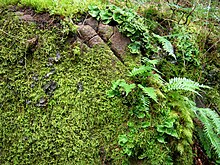Polypodium glycyrrhiza
| Polypodium glycyrrhiza | |
|---|---|
 |
|
| Scientific classification | |
| Kingdom: | Plantae |
| Division: | Pteridophyta |
| Class: | Polypodiopsida/Pteridopsida (disputed) |
| Order: | Polypodiales |
| (unranked): | Eupolypods I |
| Family: | Polypodiaceae |
| Genus: | Polypodium |
| Species: | P. glycyrrhiza |
| Binomial name | |
|
Polypodium glycyrrhiza D.C.Eaton |
|
Polypodium glycyrrhiza, commonly known as licorice fern, many-footed fern, and sweet root, is a summer deciduous fern native to western North America, primarily in a narrow strip in southern Alaska, southwestern Yukon Territory, western British Columbia, Washington, Oregon, and California, though two highly disjunct populations are known from Idaho and Arizona. It thrives in a humid climate, prevailing in areas with cool and moist summers and warm and wet winters. P. glycyrrhiza can often be found growing on the trunks and branches of winter deciduous trees, particularly bigleaf maple, but is also often found on rocks, logs, and wet, mossy humus. It takes advantage of the mild, wet winters and the substrate of deciduous trees to photosynthesize and grow during the cold season when most other temperate plants are dormant. Habitat elevation is lowlands below 600 meters.
Licorice fern acquires its name from its licorice-flavored rhizome, which was chewed for flavor by numerous Native American groups, including the Squamish, Shishalh, Comox, Nuxalk, Haida, and Kwakwaka'wakw. The rhizomes were also usually used medicinally as a treatment for the cold and sore throats.
Spores are located in rounded sori on the undersides of the fronds, and are released in cool weather and high humidity.
...
Wikipedia
